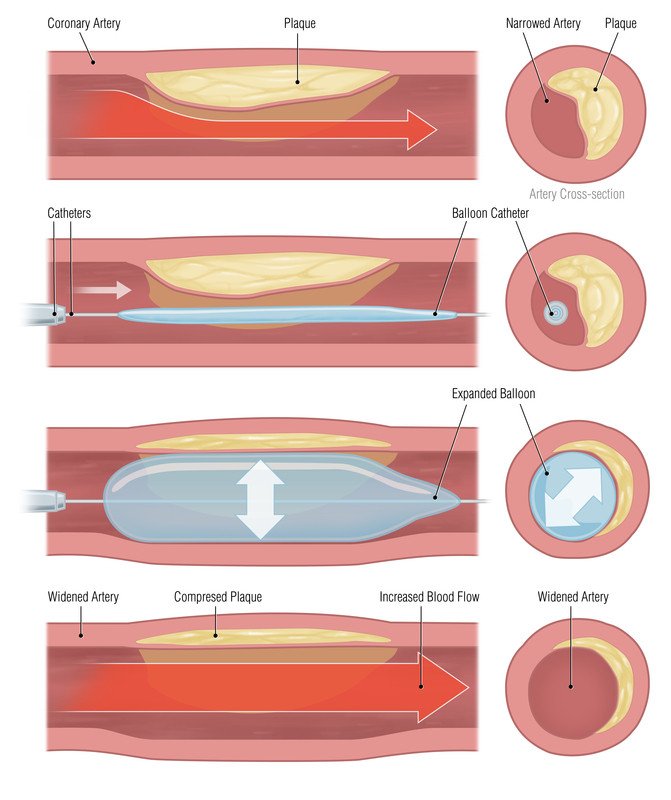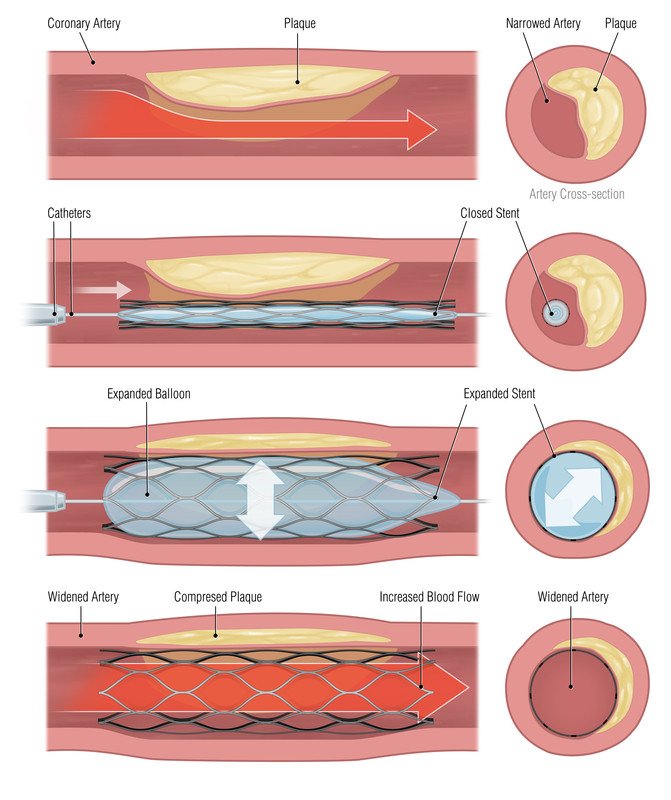Angioplasty
Medically reviewed by Drugs.com. Last updated on May 3, 2024.
What is an Angioplasty?

Angioplasty is a procedure in which a tiny device is inserted into narrowed blood vessels that supply blood to the heart. This device widens the arteries and increases blood flow.
Balloon angioplasty, also known as percutaneous transluminal coronary angioplasty (PTCA), uses a small, thin tube (called a catheter) with a tiny balloon at its tip. The tube is inserted into the bloodstream through a large vessel in the arm or leg. By watching the progress of the tube on an X-ray, the cardiologist guides the tube into the heart, where it is inserted into a narrowed coronary artery. The tiny balloon is then inflated to widen the narrowed area.
|
|
During most of these procedures, cardiologists also insert a metal wire frame that serves as a scaffolding to help keep the artery open. This device is called a stent. A blocked artery is less likely to close up if a stent is in place. Even with a stent in place, the artery can still close up.
There are two types of stents:
- Bare metal stents
- Drug coated stents
Even with a stent in place, the artery can still close up. A blood clot can form inside the stent or later scar tissue can build up narrowing the artery. With both types of stents, you must take anti-platelet drugs to prevent blood clot formation. The drug coated stents inhibit tissue overgrowth. But they require you take anti-platelet drugs for a longer period of time compared to bare metal stents.
Atherectomy uses a device to cut into the plaque, physically removing it from the lining of the affected blood vessel. This is often done along with balloon angioplasty or stenting.
What It's Used For
Angioplasty is used to widen coronary arteries that have been narrowed significantly by fatty plaques. How do you know if your arteries are narrowed or clogged? Many patients go to their doctors complaining of chest pain or other symptoms of coronary artery disease. Your doctor will review your medical history, will ask whether you have any relatives with heart disease, and will examine you. You also may need blood tests, an electrocardiogram (EKG), stress testing or echocardiography to help to determine if you should have angioplasty. If your doctor thinks your chest pain is a heart attack in progress, you will be rushed to the catheterization lab for an emergency angioplasty.
In most patients, angioplasty relieves chest pain caused by coronary artery narrowing. However, some patients will require a second coronary procedure (usually a second angioplasty) within 1 year.
Angioplasty also may be used to widen a narrowed artery in a limb, most often the femoral or iliac artery to the leg.
Preparation
Before the procedure, the doctor will review your medical history, your current medications and your allergy history. If you have any bleeding problems, or if there is any chance that you might be pregnant, tell the doctor before your procedure.
Follow your doctor's instructions about when to start or to stop taking specific medications before the procedure, as well as when you should stop eating and drinking in preparation for the procedure. You will need to remove bracelets, necklaces and watches during your angioplasty, so you may want leave those items at home.
At the hospital, you will be given local anesthesia.
How It's Done
You will have an intravenous (IV) line placed into a vein in your arm to deliver fluids and medications, and you will be given medicine to help you relax. The site on your arm or groin where the catheter will be inserted will be cleaned with an antiseptic solution. Then, the catheter will be inserted into a large blood vessel.
The doctor then guides the catheter by watching its movement on an X-ray. Once the catheter has reached your heart, it is guided into the narrowed coronary artery. If you're having balloon angioplasty, the balloon will be inflated for 20 to 30 seconds. This pushes the plaque against the artery walls, allowing more blood to move through. If a stent is being used, the balloon will expand inside the stent, and push it outward against the wall of the artery. The balloon is deflated and the catheter is pulled back.
|
|
Next, an X-ray dye will be injected into the artery. This makes it possible for the doctor to see if blood is moving through and if the procedure was successful. You will receive blood-thinning medications to decrease the chance that the blockage will re-close immediately.
After the procedure, the catheter is removed, and you return to your hospital room or coronary care unit where your heart rate, pulse and blood pressure are monitored. Your doctor will tell you when you can start eating and drinking again. You will need to stay in the hospital for one to three days.
Follow-Up
Before you leave the hospital, your doctor will tell you when you should return to his or her office for a follow-up visit. You may be given prescriptions for medications to reduce the risk that your newly widened arteries will abruptly narrow again or close. Ask your doctor about when you can resume exercising and driving.
Risks
Although coronary angioplasty is generally a safe procedure, there is some risk, including:
- A heart attack
- The need for emergency coronary artery bypass surgery
- A stroke
- Puncture of a blood vessel or the heart
- Bleeding, a blood clot or an infection at the catheter insertion site
- A blocked blood vessel in the arm or leg where the catheter was inserted
- An allergic reaction to the X-ray dye
Because some of these problems may be life threatening, coronary angioplasty should always be done in a hospital that has the necessary equipment and personnel to deal with any complications immediately.
When To Call a Professional
After you leave the hospital, call your doctor right away if:
- You develop chest pain, shortness of breath, dizziness or an irregular heartbeat.
- You have a fever.
- The catheter insertion site becomes red, swollen and painful, or it oozes blood.
- The limb where the catheter was inserted becomes painful, cold and pale, with a weak or absent pulse.
Additional Info
National Heart, Lung and Blood Institute (NHLBI)
http://www.nhlbi.nih.gov/
American Heart Association (AHA)
http://www.heart.org/
Further information
Always consult your healthcare provider to ensure the information displayed on this page applies to your personal circumstances.


